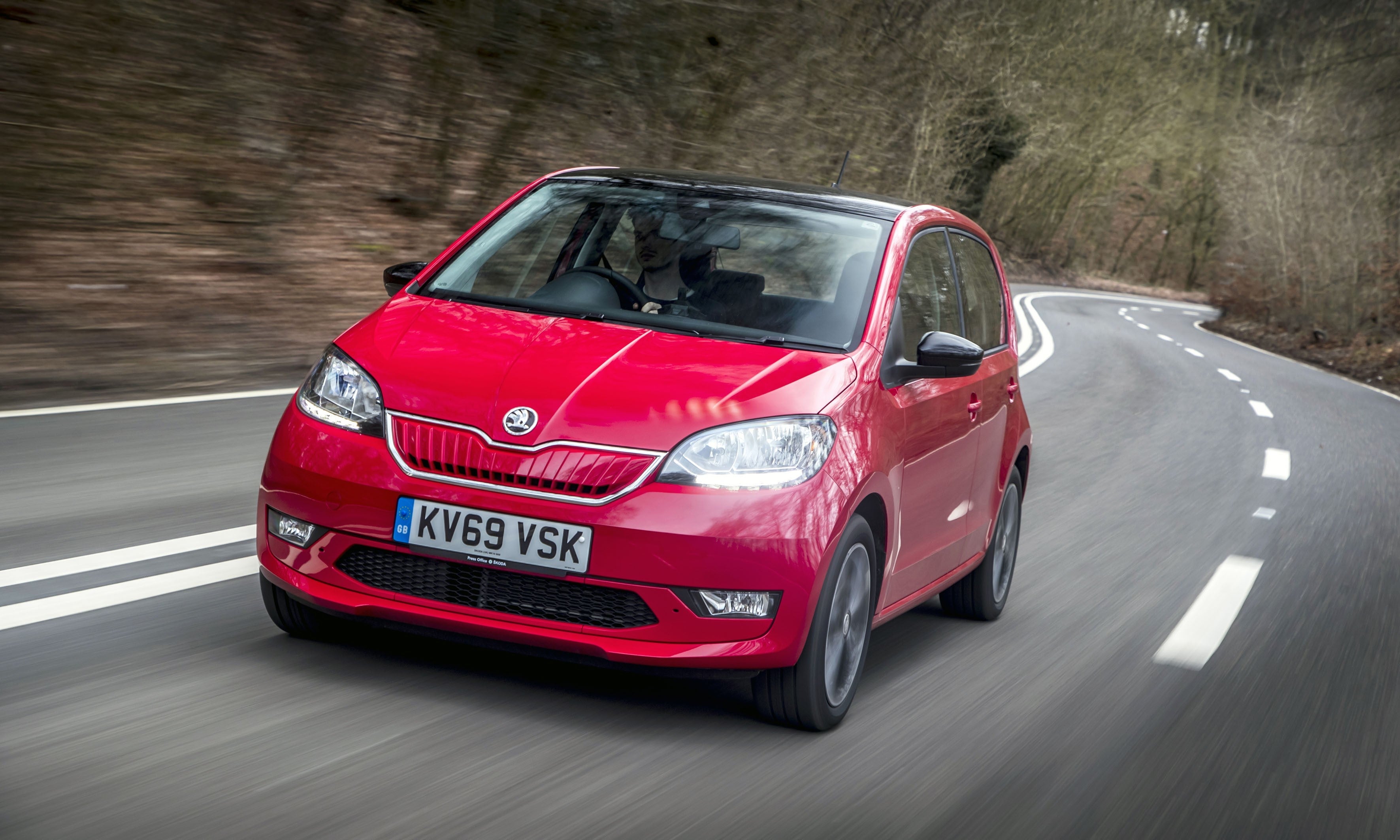Skoda Citigo-e iV (2020-2021) Review
Written by Andrew Brady
Quick overview
Pros
- Driving experience is enhanced by electric power
- Should provide super-low running costs
- Beats petrol if you’re driving in the city
Cons
- Range is slightly lower than key rivals
- A bit dull inside
- Fast-charge system costs extra
Overall verdict on the Skoda Citigo-e iV
"Some aspects of the Skoda Citigo-e iV are showing their age, but on balance it proves that modern electric cars are as capable as petrol-powered equivalents, and are better still in many aspects. It still requires a sizeable financial commitment but should reward that investment with low running costs."
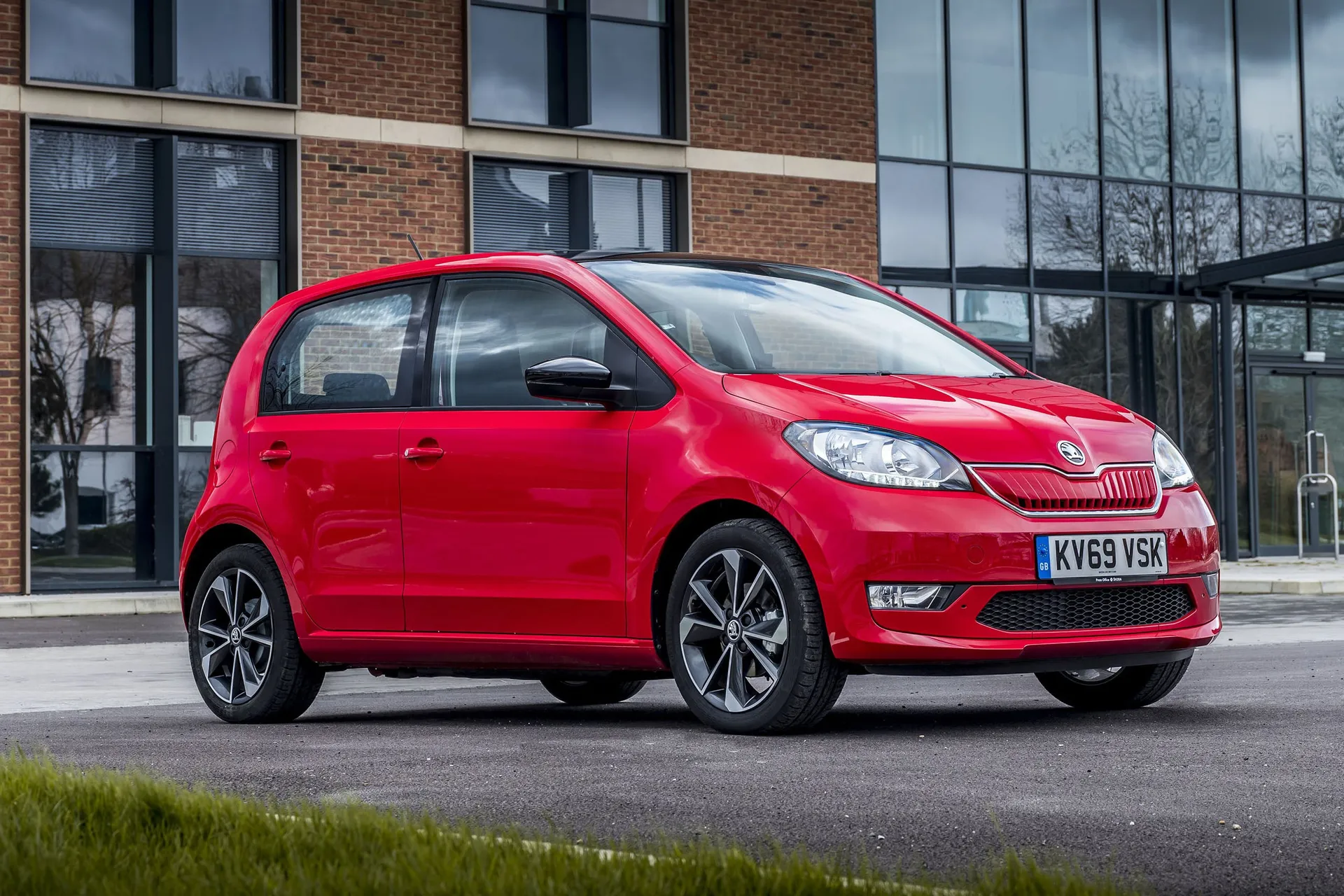
There’s a good chance you’re already familiar with the Skoda Citigo - at least in its past life. First introduced in 2012 and then discontinued in 2019, the Citigo was Skoda’s entry into the city car class. It was successful too, bringing a lot of quality to the segment alongside its near-identical Volkswagen and SEAT sister cars, the Up and the Mii. But how does that success switch to electric power? Read our full Skoda Citigo-e iV review to find out.
When Skoda's parent company Volkswagen made a big switch to EVs, it took all its brands with it. As a result, the Skoda Citigo, Volkswagen up!, and SEAT Mii have ceased production entirely.
Visually there was not much to distinguish the Citigo-e iV (to give it its full name) from the regular Citigo, except for the front grille which was almost completely blanked off and some discreet badges. It remained a design based on getting as much interior space as possible, which meant a boxy body with very short overhangs, a short bonnet and an almost vertical tailgate. It’s aged very well, considering the basic shape is approaching ten years old, and particularly in a higher specification; it looks quite fresh.
There were few surprises when you got inside too, as the vast majority of the cabin was carried over from the normal Citigo. A large glazed area helped the feeling of space and gave good visibility, helped by a slim dashboard. All the major controls were grouped closely together in the centre, but the Citigo e did without a central touchscreen like you got in some EV rivals of the era, so you had to use your smartphone to make phone calls and stream music on the move.
There was a single drivetrain choice for the Citigo-e iV, an electric motor providing up to 83PS and 212Nm of torque, with a continuous power output of 55PS through a single-speed automatic gearbox driving the front wheels. The battery pack was 36.8kWh, which gave the Citigo-e iV a WLTP range of 161 miles.
Driving the Citigo-e iV was everything you could wish for from an electric car back then; there was lots of torque for quick acceleration from low speeds, and you could adjust the amount of regenerative braking so you could use the brake pedal less. The rest of the driving experience was barely distinguishable from the original Citigo, but arguably better. It was quieter, just as comfortable and even more relaxing - as well as being cheaper to run.
As an overall package, the Citigo-e iV was even more impressive than the original petrol car. It offered the same space efficiency and sense of quality, but added zero emissions, lowering running costs, and was arguably more fun to drive. If you could live with the purchase price, it was a great way to get into EV ownership.
Looking for a used car for sale? We've got 100s of Skoda Approved Used Cars for Sale for you to choose from, including a wide range of Skoda Citigo-e iV cars for sale.
Is the Skoda Citigo-e iV right for you?
The Skoda Citigo-e iV was a breeze to drive, while the low noise levels and brisk urban performance were backed up by quick steering and a comfortable ride, which made it an ideal choice for city dwellers. Low running costs were a big plus too, once you got past the initial purchase price. Anyone looking for a near-perfect used city car should give it serious consideration, even if you do have to undertake longer journeys on occasion.
As for rivals, its in-house competition from the Volkswagen e-Up and the SEAT Mii Electric were different only in price and looks, while the Renault Zoe was a little bigger and more expensive, but offered a more grown-up cabin, better performance and increased range, which made it suitable for a wider audience.
What’s the best Citigo-e iV model/engine to choose?
Unlike the Mii Electric, the Citigo-e iV was available in two specifications. The basic trim was the Skoda Citigo-e iV SE, and came with climate control, a height-adjustable driver’s seat and a DAB radio with a touchscreen display. The more expensive SE L version added better seat fabric, a smarter dashboard panel, automatic headlights and windscreen wipers.
Most crucially, however, the Skoda Citigo-e iV SE L came with a Combined Charging System as standard - originally an option on the SE - which meant you could use public fast-charging points and get an 80% charge in an hour. It was £700 to upgrade the SE to the CCS system, but we would say it's worth finding a car with this fitted as it's still an essential piece of kit.
What other cars are similar to the Citigo-e iV?
Look no further than the SEAT Mii Electric and Volkswagen e-Up if it’s similarity you’re looking for, so consider all three before choosing the bare minimum. The Mii Electric and e-Up were single-model ranges unlike the Citigo, so it was easy to compare price and specification when buying new.
The other main rival in the small EV sector was Renault’s Zoe, and although it was a slightly bigger car and therefore more expensive, it came in a choice of two power outputs, two charging modes, and three trim levels, so it was easier to pick the car you need.
Like the SEAT, Volkswagen and Skoda, the Zoe was canned in favour of Renault's new 4 and 5 electric cars. Both are wonderfully quirky and aren't much bigger than the Zoe.
Comfort and design: Skoda Citigo-e iV interior
"It's well over 10 years old, but the basic design of the Citigo has stood the test of time. Cleverly, the notion of it running on electric power was designed from the beginning, so the transformation didn't result in compromise to make the additional electric hardware fit."

There were plenty of welcome familiarities when you climbed aboard. The driving position was excellent, with plenty of seat adjustment - height adjustment was standard for the driver. The squared-off exterior paid dividends for the driver too, providing a good view out all around, and the near-vertical rear window made it easy to judge where the back of the car was when reversing.
The dashboard was as simple as it came back then, which dated it a little compared to the modern touchscreens that are commonplace these days. The control layout was simple and easy to understand though, with all the major controls grouped neatly and high up on the dashboard where it was easy for driver and passenger to access them.
The same went for the instrument display, which had a large central speedometer and supplementary dials keeping you informed on the amount of battery charge remaining and how much power was being used on the move. You could get in and understand how it all worked and where everything was within seconds, which was a testament to the quality of the design.
Quality and finish
Although it was no spring chicken, the Citigo-e iV compared with newer rivals in some aspects of its quality and finish. It was based on a city car, so the relatively sparse cabin felt quite stripped back compared to some rivals. Some of the materials felt hard to the touch but appeared tough rather than cheap, and you still got a reassuring click when operating the controls, giving off strong vibes that this was a quality product.
There was a sizeable step in how luxurious the Skoda Citigo-e iV SE felt in comparison to the more expensive Citigo-e SE L. The amount of dark-coloured trim and fabrics was a reminder that you were in the basic version, and although the SE L wasn’t much brighter, there was a bit more design flair on the seats and the dashboard.
It was also helped by leather on the steering wheel and gear lever as the main contact points. Unfortunately, there was also nothing on the options list to add to the interior other than practical features, so you had to go for a bright exterior colour if you wanted a bit more life in the cabin.
Infotainment: Touchscreen, USB, sat-nav and stereo in the Skoda Citigo-e iV
As standard both versions of the Skoda Citigo-e iV got a DAB radio with touchscreen operation, six speakers, and a smartphone cradle which connected via Bluetooth to give you phone operation and audio streaming, as well as a host of other features through the Fun&Move app, available for both Android and iOS devices.
The Fun&Move app added greater functionality to the Skoda Citigo-e iV, and was even more useful with an electric motor. It included a car finder so you could recall the location of your car as well as the address and time you parked. Remote charging operation and control of the air conditioning and a remote departure timer were also available, so you could ensure your car was charged and even warmed up or cooled down ready for you to drive away. It even allowed you to defrost your windscreen on cold days so you could leave when you want to on a frosty morning.
As an option, the Skoda Citigo-e iV was also available with a multimedia holder and an adjustable tablet case that allowed rear-seat passengers to view the screens hands-free.
Space and practicality: Skoda Citigo-e iV boot space
The Skoda Citigo-e iV had almost no changes to the bodywork during its conversion to electric power, so it remained a design that had interior space as a top priority - hence the squared-off looks and chunky proportions. It was also important to note that ditching the engine for electric hardware didn't impact the space a great deal either; the batteries were under the rear seat, making it 5cm higher than before, but that had little impact on overall headroom.
Even though it is an old design now, it’s still impressive to witness just how much space was available in the front seats. A driver of any height could get comfortable behind the wheel, even though the steering only adjusted for reach, with plenty of head and legroom. Shoulder room was decent too, despite the Skoda Citigo-e iV not being particularly wide. The feeling of space was helped by the relatively stripped-back interior and the large glazed area, which maximised the amount of light coming into the cabin.
Rear seat space was less generous but was more than acceptable given the exterior dimensions. The rear seats were mounted 5cm higher than those in the front, so there was a fraction less headroom, while legroom was understandably less plentiful.
Still, there was enough space to accommodate willing adults for shorter journeys. All Skoda Citigo-e iV models were five-doors only, unlike the three-door option of the previous petrol models, but was also a strict four-seater, with a rear bench designed for two and a pair of seatbelts rather than three, unlike rivals like the Renault Zoe.
Despite the addition of electrical hardware, the boot space on offer was impressive and was the same as the petrol version at 251 litres. Folding the rear seats expanded to a massive 959 litres, and there was an adjustable boot floor too so you could stash precious items away from prying eyes.
There was a useful amount of storage space in the cabin too, including decently-sized door bins that could hold a 1-litre bottle, a dinky cubby ahead of the gear lever - with a removable insert designed to hold a smartphone - plus a larger than average glovebox. A tyre repair kit was standard, and a spare wheel of any variety was not an option.
If you're looking for an electric car that can be squeezed into your garage, you'll want to know the Skoda Citigo-e iV's exterior dimensions. It's 3597mm long, 1645mm wide and 1481mm high.
Handling and ride quality: What is the Skoda Citigo-e iV like to drive?
"The Skoda Citigo-e iV may have been an electric car based on a humble city car, but neither impacted its capabilities outside and inside the city."
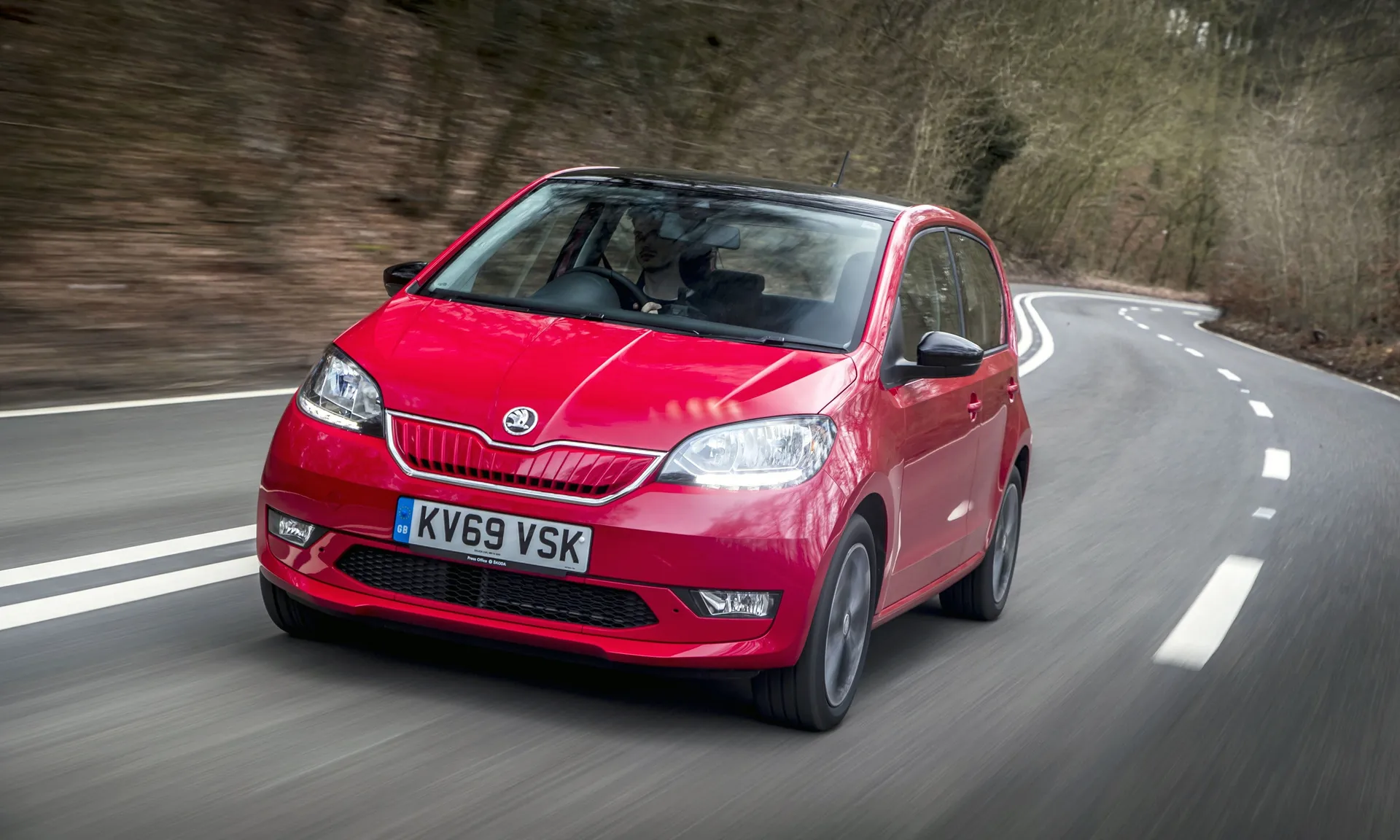
The good news is that it was impressively adept whatever the conditions, and demonstrated a level of composure and fun that you didn't necessarily expect from a car like this. It takes just a few moments to discover that the Skoda Citigo-e iV feels like a big car in the way it behaves, never feeling out of its depth regardless of the kind of road it’s on.
The steering still remains a pleasure to use, being light enough but not overly so at all speeds and satisfyingly accurate, so you know exactly what is happening down at the front wheels. Whether you’re cruising on the motorway or battling your way through a traffic jam, the Mii makes you feel like you have full control and is confidence-inspiring as a result.
Another plus is that the ride quality is composed and refined for a car of this size. It makes short work of soaking up imperfections regardless of size and severity, which is of particular use when in the city and having to negotiate roads that are more commonly in a poor state.
In some respects, the Skoda Citigo-e iV is even more fun to drive than the regular Citigo when the mood takes you. The accuracy of the steering keeps you fully informed about how much grip there is, and because performance at lower speeds is plentiful, it’s quick enough to get you between the corners at speed.
Body roll is kept well in check - helped by the fact that the heavy batteries are low down in the body - and there’s definitely something about an electric car being so much fun to drive that it feels like you’re beating the system. If you have the idea that electric cars are boring, try this first.
What engines and gearboxes are available in the Skoda Citigo-e iV?
There was just one motor and battery pack option for the Skoda Citigo-e iV - a single motor driving the front wheels that offers a continuous output of 55PS (for cruising) with a maximum output of 83PS for short bursts of acceleration. More crucial to the driving experience was the 212Nm of torque, which contributed to the surprisingly strong acceleration, especially from lower speeds.
This was still a relatively lightweight car at 1235kg - about the same as a same-era Ford Fiesta - and with maximum torque from a standstill, the Skoda Citigo-e iV could jump away from traffic lights with surprising alacrity. If you weren't careful, you’d feel the wheels spin before the traction control kicked in. Around town, this boundless thrust at lower speeds made it huge fun to drive.
Get out of the city and the Skoda Citigo-e iV was less at ease. It could manage motorway speeds and be wound all the way up to 81mph, but acceleration at these speeds was much slower and the battery depleted far more quickly at these speeds, too. The Citigo-e iV came with three drive modes - Normal, Eco and Eco+. The latter two modes restricted the amount of power delivered to the wheels to improve the range, with Eco+ also switching off the air-con.
The gearbox was a simple automatic with Park, Drive and Neutral, although you also had the option to adjust the strength of the regenerative braking that fed energy back into the battery. Using this instead of the actual brakes helped to improve the range, and with it set to the highest level you could almost drive everywhere without touching them.
Refinement and noise levels
The previous generation Skoda Citigo was a relatively refined car given its cost and city car status, but the switch to electric power improved its performance. It was solidly built from the ground up, and you felt that from the door slam to how it behaved on the road; it shrugged off lumps and bumps comfortably which was a welcome bonus in a car this size.
Better yet, the near-silence of the electric powertrain meant that at low speeds the Citigo-e iV was comfortably quieter than cars costing thousands more. Below 20mph all you heard was a distant whine from the motor - far quieter than any combustion engine - and it enhanced the driving experience greatly.
Wind and tyre noise began to make themselves known at higher speeds, partly because they were thrown into sharper relief as there was no petrol engine to drown them out. The reality was that, out of town and motorway speeds, the noises all blended into each other, so you got general white noise accompaniment, something that's often preferred to the drone of an exhaust pipe.
Safety equipment: How safe is the Skoda Citigo-e iV?
Overall, the Skoda Citigo-e iV scored three stars from Euro NCAP, with strong scores of 81% rating for adult protection, 83% for child protection. Less impressive were the scores for pedestrians at 46% and 55% for safety assist.
Standard equipment included driver and passenger front airbags, side airbags covering front and rear seats, seat belt pre-tensioners and load limiters front and rear and Isofix child seat mounting points. The Skoda Citigo-e iV also came with electronic stability control, hill-hold assist and lane assist as standard, with tyre-pressure monitoring and traffic-sign recognition included.
One of the reasons for the Skoda Citigo-e iV's lower score in the Euro NCAP test compared to the original petrol version tested in 2011 was that Automatic Emergency Braking was not available as standard or as an option, something far less common back in 2011. Another feature not available on the Citigo-e iV was an automatic sound generator; a system emitting a faint noise to warn pedestrians that the vehicle was in motion.
Maximum EV range in the Skoda Citigo-e iV
The quoted range for the Skoda Citigo-e iV under the WLTP criteria was 161 miles - less than rivals like the Renault Zoe but more than some older electric cars still on the market. The reality was that for many drivers considering an electric vehicle this would be enough - 130 miles was achievable on a full charge, so even a commute of 50 miles or more each way, every day would've still been possible without having to charge during the day.
Charging times and cost: How much does it cost to charge the Skoda Citigo-e iV?
"The beauty of an electric car is that running costs are arguably significantly lower than any petrol or diesel car on the market, and generally speaking an electric car is more efficient in town at lower speeds than at a constant speed on a major road, unlike a conventionally-engined car."
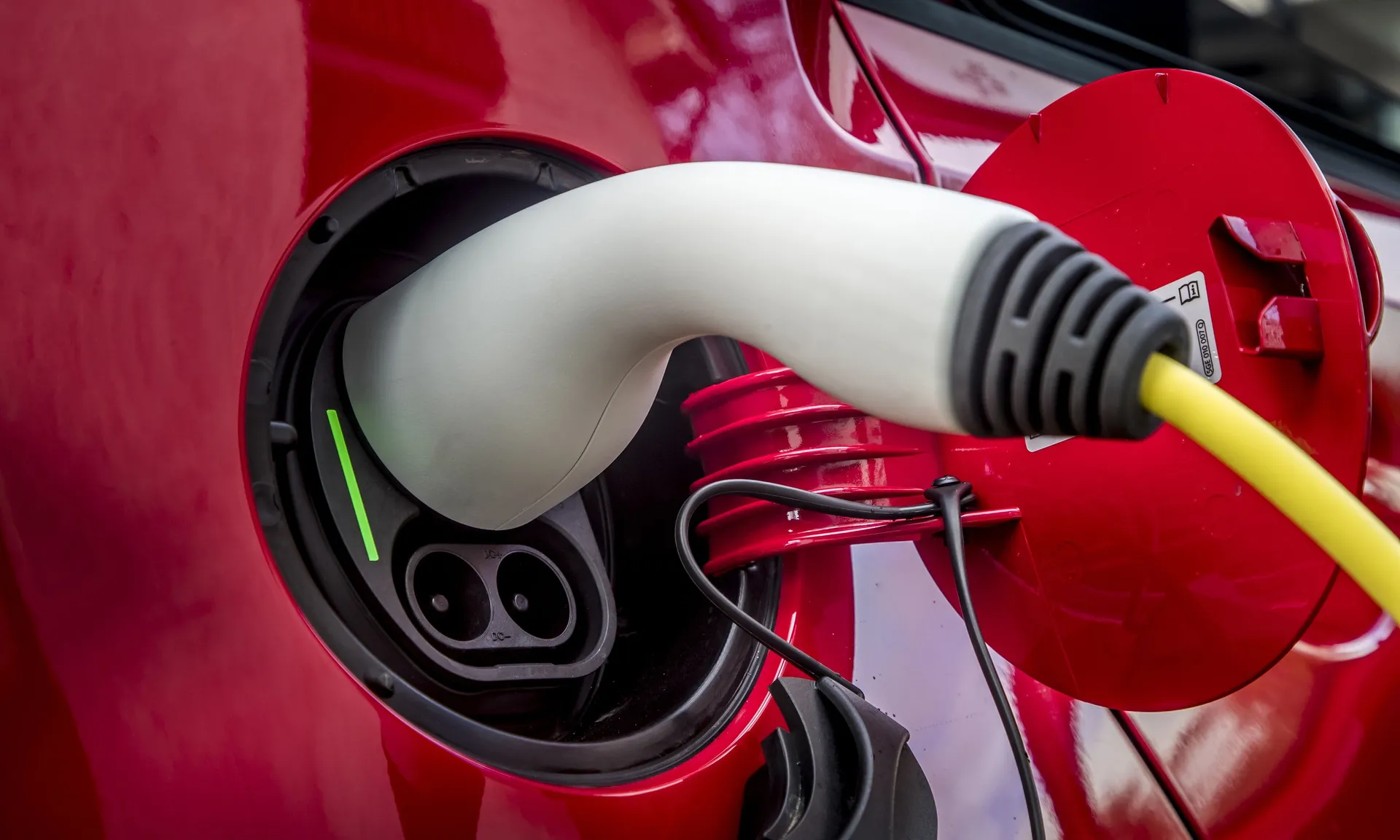
The beauty of an electric car is the running costs are arguably significantly lower than any petrol or diesel car on the market, and generally speaking an electric car is more efficient in town at lower speeds than at a constant speed on a major road, unlike a conventionally-engined car.
Expect to pay as little as £6 for an overnight charge at home on a cheap tariff. Higher-speed charging at public will cost more, but a 40kW DC charge can take the Skoda Citigo-e iV from zero to 80% charge in one hour - but only if you choose a Skoda Citigo-e iV SE L with CCS charging.
Skoda Citigo-e iV reliability and warranty
Electric cars are generally very reliable, with fewer mechanical parts than petrol or diesel models. The Skoda Citigo-e iV is no exception – we've heard of very few reports of issues.
Skoda Citigo-e iV insurance groups and costs
Compared to the standard Skoda Citigo-e iV, the electric version unfortunately came with a significantly higher insurance bracket. Both models fall into group 11 but the SEL is 12.
Given the purchase price, insurance premiums are relatively high for a city car, but not for an electric car - with a decent few years of no-claims bonus the Citigo-e iV compares favourably with other used small cars like the Fiesta or Polo.
VED car tax: What is the annual road tax on a Skoda Citigo-e iV?
After fuel, the biggest saving you would've enjoyed by purchasing a Skoda Citigo-e iV was the zero rate VED. Unfortunately, for cars registered between 1 April 2017 and 31 March 2025, this is risen from £0 to £195.
Skoda Citigo-e iV price
"The Skoda Citigo-e iV is still very new, so there are limited used examples on the market, although you will find a mix of pre-reg and nearly-new models if you look hard enough."
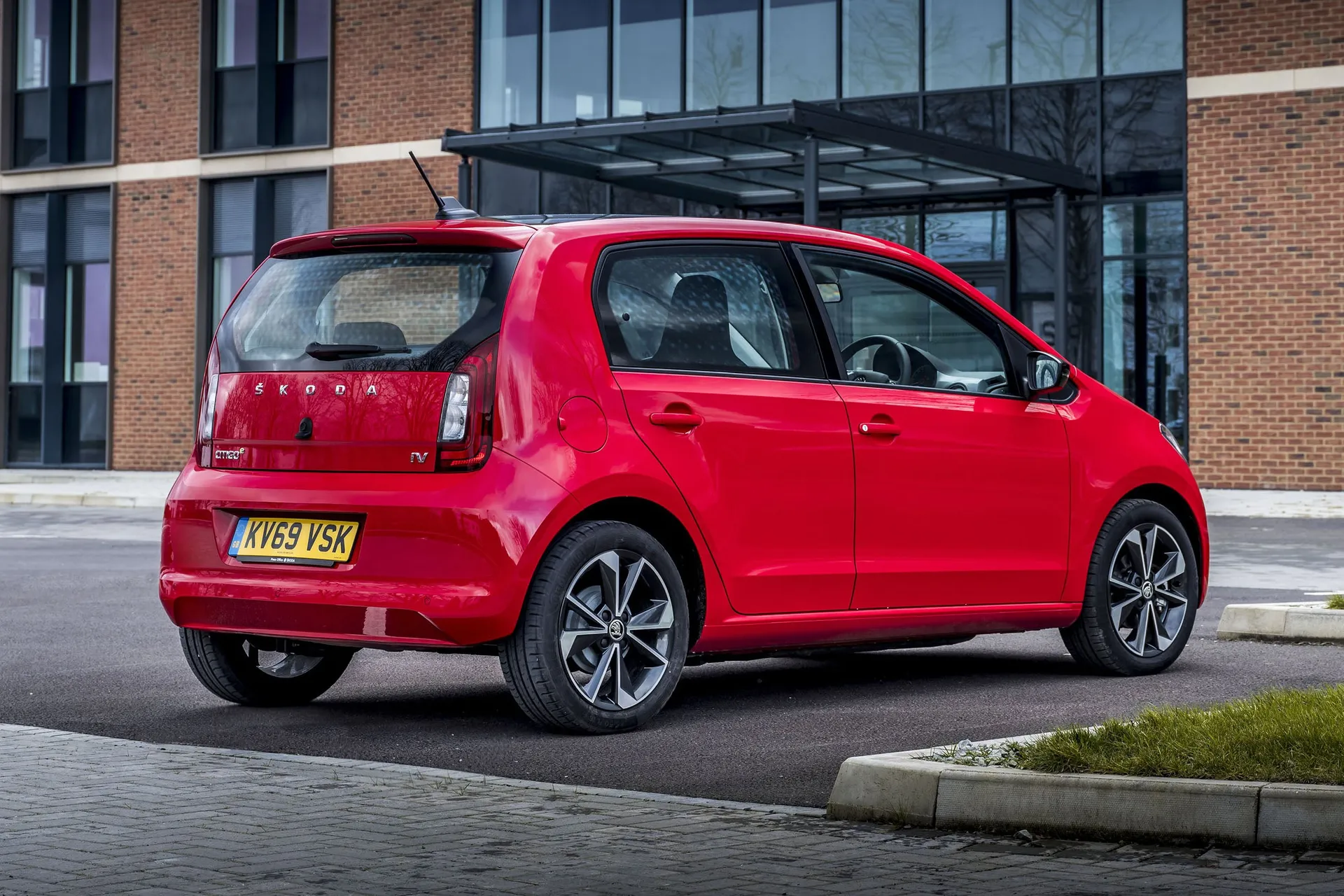
There aren't many used examples available at the time of writing with only seven cars popping up. These little electric city-goers hold their value well with the cheapest car starting from £9,150.
If you have a bit more to spend, low-mile examples can be had for around £11,700.
Trim levels and standard equipment
With just two versions of the Skoda Citigo-e iV available, it shouldn’t take long to decide. The standard specification on the SE model was good, with essentials like climate control and Bluetooth so you could connect up the Move&Fun app. However, the fast-charge CCS system is still essential.
The Skoda Citigo-e iV SE L added bigger alloy wheels, heated seats and mirrors, automatic wipers and headlights plus some visual upgrades to the exterior and interior, but didn't include features like cruise control. It's worth looking out for the winter pack, which was added to the Citigo-e iV SE L.
Ask the heycar experts: common questions
What is the electric range of the Skoda Citigo-e iV?
Has the Skoda Citigo-e iV been discontinued?
How expensive is a Skoda Citigo-e iV?
Get our latest advice, news and offers
Keep me updated by email with the latest advice, news and offers from heycar.
By submitting you agree to our privacy policy
